SOLVING RATIONAL INEQUALITIES EXAMPLES
Solve for x :
Example 1 :
(x + 2)/(x – 3) < 0
Solution :
Let f(x) = (x + 2)/(x – 3)
f(x) < 0
(x + 2)/(x – 3) < 0
By equating the numerator and denominator to zero, we get
x + 2 = 0, x – 3 = 0
x = -2 and x = 3 (critical numbers)
The critical numbers are dividing the number line into three intervals.
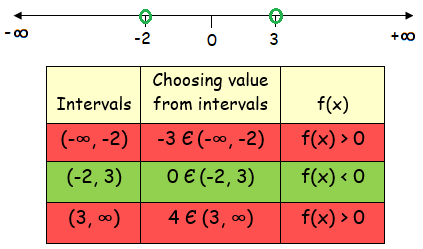
From the table, the possible values of x are
-2 < x < 3
By writing it as interval notation, we get
(-2, 3)
So, the required solution is -2 < x < 3
Example 2 :
(x + 3)/(2 – x) < 0
Solution :
Let f(x) = (x + 3)/(2 – x)
f(x) < 0
(x + 3)/(2 – x) < 0
By equating the numerator and denominator to zero, we get
x + 3 = 0, 2 – x = 0
x = -3 and x = 2 (critical numbers)
The critical numbers are dividing the number line into three intervals.
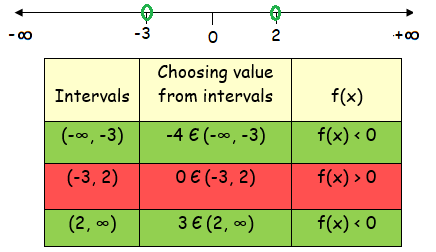
From the table, the possible values of x are
x < -3 or x > 2
By writing it as interval notation, we get
(-∞, -3) u (2, ∞)
So, the required solution is x < -3 or x > 2
Example 3 :
(x - 1)/(x + 3) ≥ -1
Solution :
Let f(x) = (x - 1)/(x + 3)
f(x) ≥ -1
(x - 1)/(x + 3) ≥ -1
Add 1 on both sides, we get
(x - 1)/(x + 3) + 1 ≥ -1 + 1
Taking least common multiple, we get
[(x – 1) + (x + 3)]/(x + 3) ≥ 0
(x - 1 + x + 3)/(x + 3) ≥ 0
(2x + 2)/(x + 3) ≥ 0
By equating the numerator and denominator to zero, we get
2x + 2 = 0, x + 3 = 0
x = -1 and x = -3 (critical numbers)
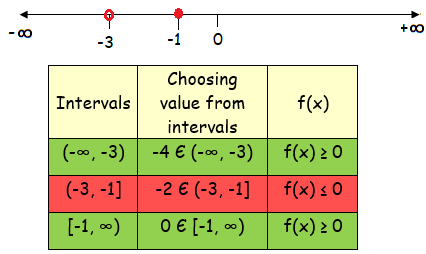
From the table, the possible values of x are
x < -3 or x ≥ -1
By writing it as interval notation, we get
(-∞, -3) u [-1, ∞)
So, the required solution is x < -3 or x ≥ -1
Example 4 :
(x + 2)/(2x - 3) < 1
Solution :
(x + 2)/(2x - 3) < 1
Subtract 1 on both sides, we get
(x + 2)/(2x - 3) - 1 < 1 – 1
(x + 2)/(2x - 3) - 1 < 0
Taking least common multiple, we get
[(x + 2) + (-2x + 3)]/(2x - 3) < 0
(x + 2 - 2x + 3)/(2x - 3) < 0
-(x - 5)/(2x - 3) < 0
Make a coefficient x as positive, so we have to multiply by -1 through out the equation,
(x - 5)/(2x - 3) > 0
By equating the numerator and denominator to zero, we get
x - 5 = 0, 2x - 3 = 0
x = 5 and x = 3/2 (critical numbers)
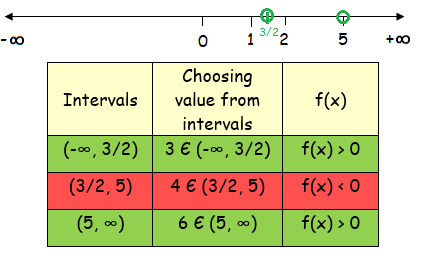
From the table, the possible values of x are
x < 3/2 or x > 5
By writing it as interval notation, we get
(-∞, 3/2) u (5, ∞)
So, the required solution is x < 3/2 or x > 5
Example 5 :
(5 – 2x)/(1 - x) > 4
Solution :
(5 – 2x)/(1 - x) > 4
Subtract 4 on both sides, we get
(5 – 2x)/(1 - x) - 4 > 4 – 4
(5 – 2x)/(1 - x) - 4 > 0
Taking least common multiple, we get
[(5 – 2x) - 4(1 - x)]/(1 - x) > 0
(5 – 2x - 4 + 4x)/(1 - x) > 0
(2x + 1)/(1 - x) > 0
By equating the numerator and denominator to zero, we get
2x + 1 = 0, 1 - x = 0
x = -1/2 and x = 1 (critical numbers)
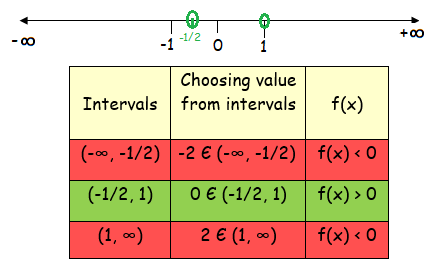
From the table, the possible values of x are
-1/2 < x < 1
By writing it as interval notation, we get
(-1/2, 1)
So, the required solution is -1/2 < x < 1.
Example 6 :
(x - 1)/(x + 2) ≤ 0
Solution :
(x - 1)/(x + 2) ≤ 0
Equating the denominator to 0, we get
x = -2
x - 1 = 0
x = 1
(-∞, -2) (-2, 1) and (1, ∞)
|
Intervals (-∞, -2) |
Choosing values from intervals When x = -3 (-3 - 1)/(-3 + 2) + |
f(x) > 0 |
|
(-2, 1) |
When x = 0 (0 - 1)/(0 + 2) - |
< 0 |
|
(1, ∞) |
When x = 2 (2 - 1)/(2 + 2) + |
> 0 |
So, the solution is -2< x ≤ 1.
Example 7 :
[(2x - 3)/(x + 5)] ≥ [(2x + 7)/(x - 3)]
Solution :
[(2x - 3)/(x + 5)] ≥ [(2x + 7)/(x - 3)]
[(2x - 3)/(x + 5)] - [(2x + 7)/(x - 3)] ≥ 0
[(2x - 3)(x - 3) - (2x + 7)(x + 5)]/(x + 5)(x - 3) ≥ 0
(2x2 - 9x + 9) - (2x2 + 17x + 35)/(x + 5)(x - 3) ≥ 0
(-26x - 26) / (x + 5)(x - 3) ≥ 0
-26 (x + 1) / (x + 5)(x - 3) ≥ 0
26 (x + 1) / (x + 5)(x - 3) ≤ 0
Zeroes are -5 and 3.
Equating the numerator to 0, we get x = -1
(-∞, -5) (-5, -1) (1, 3) and (3, ∞).
|
Intervals (-∞, -5) |
Choosing values from intervals When x = -6 26 (-6 + 1) / (-6 + 5)(-6 - 3) - |
f(x) < 0 |
|
(-5, -1) |
When x = -2 26 (-2 + 1) / (-2 + 5)(-2 - 3) + |
> 0 |
|
(1, 3) |
When x = 2 26 (2 + 1) / (2 + 5)(2 - 3) - |
< 0 |
|
(3, ∞) |
When x = 4 26 (4 + 1) / (4 + 5)(4 - 3) + |
> 0 |
So, the solution is (-∞, -5) U (1, 3).
Kindly mail your feedback to v4formath@gmail.com
We always appreciate your feedback.
©All rights reserved. onlinemath4all.com
Recent Articles
-
Digital SAT Math Problems and Solutions (Part - 150)
Apr 25, 25 11:46 AM
Digital SAT Math Problems and Solutions (Part - 150) -
AP Calculus AB Problems with Solutions (Part - 19)
Apr 24, 25 11:10 PM
AP Calculus AB Problems with Solutions (Part - 19) -
AP Calculus AB Problems with Solutions (Part - 18)
Apr 24, 25 11:06 PM
AP Calculus AB Problems with Solutions (Part - 18)
